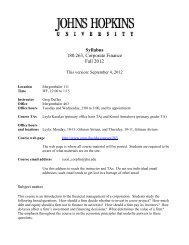WEALTH, DISPOSABLE INCOME AND CONSUMPTION - Economics
WEALTH, DISPOSABLE INCOME AND CONSUMPTION - Economics
WEALTH, DISPOSABLE INCOME AND CONSUMPTION - Economics
You also want an ePaper? Increase the reach of your titles
YUMPU automatically turns print PDFs into web optimized ePapers that Google loves.
2 MEASURING <strong>WEALTH</strong><br />
In a competitive economy with perfect capital markets the representative<br />
consumer’s wealth is the sum of his financial and physical assets net of liabilities<br />
(non-human wealth) plus the expected discounted value of his current<br />
and expected future after-tax labour income (human wealth). In an<br />
open economy, non-human wealth will generally include both domestic<br />
and foreign assets net of liabilities. Summing across consumers and dividing<br />
by the population yields aggregate per capita real wealth. If we define<br />
all aggregate variables in real per capita terms, real per capita wealth (W)<br />
can be written as:<br />
d<br />
W t = At + Dt + ( Lt – T t)<br />
+ Et i = 1 j = 1<br />
⎛ 1 ⎞<br />
⎜------------------- ⎟(<br />
Lt<br />
⎝1 + r + i–<br />
Tt + i)<br />
t + j⎠<br />
5<br />
(2.1)<br />
where A is net domestic and foreign physical and financial assets, is<br />
domestic holdings of government debt, L is labour income, T is taxes net of<br />
transfers, r is the real interest (or discount) rate, and Et is the expectations<br />
operator conditioned on information available at time t.<br />
If we add the assumptions of intergenerational altruism and lump<br />
sum taxes, wealth is characterized by the well-known Ricardian equivalence<br />
proposition. For a given path for government expenditures and the<br />
foreign debt, wealth is invariant to the timing of taxes and the size of the<br />
government debt. Domestically held government debt nets out of wealth,<br />
since rational consumers realize that the value of the government debt they<br />
hold is offset by future tax liabilities. This can be demonstrated by combining<br />
(2.1) with the government’s budget constraint. The government’s lifetime<br />
budget constraint requires that the present value of taxes is sufficient<br />
to pay for the present value of government expenditures plus any outstanding<br />
government debt:<br />
∞<br />
∑<br />
i<br />
∏<br />
D d




